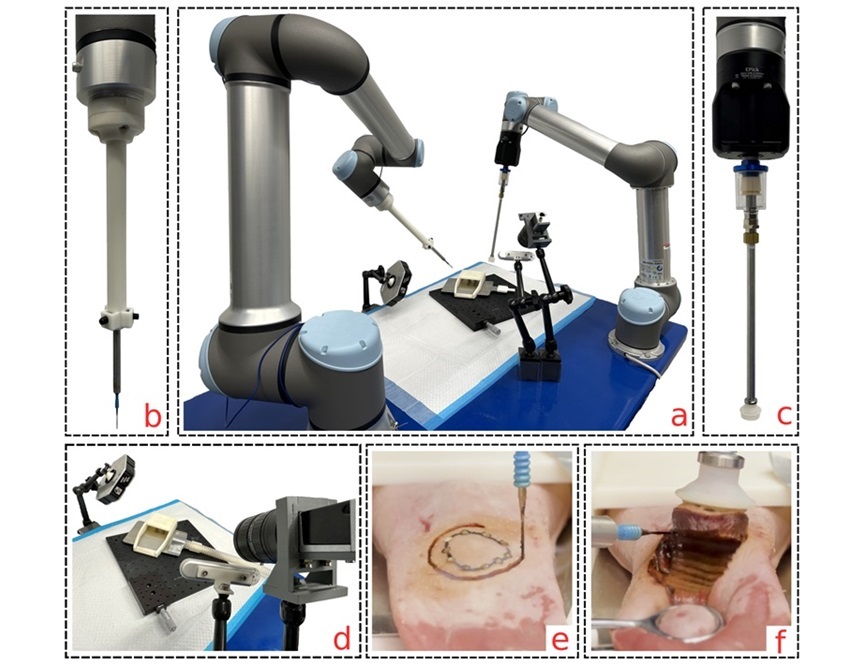Surgical Robot Outperforms Human Surgeons in Precise Removal of Cancerous Tumors
|
By HospiMedica International staff writers Posted on 20 Mar 2024 |

Surgically removing tumors from sensitive areas, such as the head and neck, poses significant challenges. The goal during surgery is to take out the cancerous tissue while saving as much healthy tissue as possible. This balance is crucial because leaving behind too much cancerous tissue can lead to the cancer's return or spread. Doing a resection that has precise margins—specifically, a 5mm margin of healthy tissue—is essential but difficult. This margin, roughly the size of a pencil eraser, ensures that all cancerous cells are removed while minimizing damage. Tumors often have clear horizontal edges but unclear vertical boundaries, making depth assessment challenging despite careful pre-surgical planning. Surgeons can mark the horizontal borders but have limited ability to determine the appropriate depth for removal due to the inability to see beyond the surface. Additionally, surgeons face obstacles like fatigue and visual limitations, which can affect their performance. Now, a new robotic system has been designed to perform tumor removal from the tongue with precision levels that could match or surpass those of human surgeons.
The Autonomous System for Tumor Resection (ASTR) designed by researchers at Johns Hopkins (Baltimore, MD, USA) translates human guidance into robotic precision. This system builds upon the technology from their Smart Tissue Autonomous Robot (STAR), which previously conducted the first fully autonomous laparoscopic surgery to connect the two intestinal ends. ASTR, an advanced dual-arm, vision-guided robotic system, is specifically designed for tissue removal in contrast to STAR's focus on tissue connection. In tests using pig tongue tissue, the team demonstrated ASTR's ability to accurately remove a tumor and the required 5mm of surrounding healthy tissue. After focusing on tongue tumors due to their accessibility and relevance to experimental surgery, the team now plans to extend ASTR's application to internal organs like the kidney, which are more challenging to access. Combining ASTR's surgical precision with advanced imaging techniques could significantly advance tumor removal procedures.
“We’ve sent the robot to make an incision before, but this is the first time we’ve done a bulk resection and taken a tumor out fully,” said team leader Axel Krieger, assistant professor of mechanical engineering at the Whiting School of Engineering. “That’s the big novelty here.”
Related Links:
Johns Hopkins
Latest Surgical Techniques News
- Bioprinted Aortas Offer New Hope for Vascular Repair
- Early TAVR Intervention Reduces Cardiovascular Events in Asymptomatic Aortic Stenosis Patients
- New Procedure Found Safe and Effective for Patients Undergoing Transcatheter Mitral Valve Replacement
- No-Touch Vein Harvesting Reduces Graft Failure Risk for Heart Bypass Patients
- DNA Origami Improves Imaging of Dense Pancreatic Tissue for Cancer Detection and Treatment
- Pioneering Sutureless Coronary Bypass Technology to Eliminate Open-Chest Procedures
- Intravascular Imaging for Guiding Stent Implantation Ensures Safer Stenting Procedures
- World's First AI Surgical Guidance Platform Allows Surgeons to Measure Success in Real-Time
- AI-Generated Synthetic Scarred Hearts Aid Atrial Fibrillation Treatment
- New Class of Bioadhesives to Connect Human Tissues to Long-Term Medical Implants
- New Transcatheter Valve Found Safe and Effective for Treating Aortic Regurgitation
- Minimally Invasive Valve Repair Reduces Hospitalizations in Severe Tricuspid Regurgitation Patients
- Tiny Robotic Tools Powered by Magnetic Fields to Enable Minimally Invasive Brain Surgery
- Magnetic Tweezers Make Robotic Surgery Safer and More Precise
- AI-Powered Surgical Planning Tool Improves Pre-Op Planning
- Novel Sensing System Restores Missing Sense of Touch in Minimally Invasive Surgery
Channels
Critical Care
view channel
Mechanosensing-Based Approach Offers Promising Strategy to Treat Cardiovascular Fibrosis
Cardiac fibrosis, which involves the stiffening and scarring of heart tissue, is a fundamental feature of nearly every type of heart disease, from acute ischemic injuries to genetic cardiomyopathies.... Read more
AI Interpretability Tool for Photographed ECG Images Offers Pixel-Level Precision
The electrocardiogram (ECG) is a crucial diagnostic tool in modern medicine, used to detect heart conditions such as arrhythmias and structural abnormalities. Every year, millions of ECGs are performed... Read morePatient Care
view channel
Portable Biosensor Platform to Reduce Hospital-Acquired Infections
Approximately 4 million patients in the European Union acquire healthcare-associated infections (HAIs) or nosocomial infections each year, with around 37,000 deaths directly resulting from these infections,... Read moreFirst-Of-Its-Kind Portable Germicidal Light Technology Disinfects High-Touch Clinical Surfaces in Seconds
Reducing healthcare-acquired infections (HAIs) remains a pressing issue within global healthcare systems. In the United States alone, 1.7 million patients contract HAIs annually, leading to approximately... Read more
Surgical Capacity Optimization Solution Helps Hospitals Boost OR Utilization
An innovative solution has the capability to transform surgical capacity utilization by targeting the root cause of surgical block time inefficiencies. Fujitsu Limited’s (Tokyo, Japan) Surgical Capacity... Read more
Game-Changing Innovation in Surgical Instrument Sterilization Significantly Improves OR Throughput
A groundbreaking innovation enables hospitals to significantly improve instrument processing time and throughput in operating rooms (ORs) and sterile processing departments. Turbett Surgical, Inc.... Read moreHealth IT
view channel
Printable Molecule-Selective Nanoparticles Enable Mass Production of Wearable Biosensors
The future of medicine is likely to focus on the personalization of healthcare—understanding exactly what an individual requires and delivering the appropriate combination of nutrients, metabolites, and... Read more
Smartwatches Could Detect Congestive Heart Failure
Diagnosing congestive heart failure (CHF) typically requires expensive and time-consuming imaging techniques like echocardiography, also known as cardiac ultrasound. Previously, detecting CHF by analyzing... Read moreBusiness
view channel
Expanded Collaboration to Transform OR Technology Through AI and Automation
The expansion of an existing collaboration between three leading companies aims to develop artificial intelligence (AI)-driven solutions for smart operating rooms with sophisticated monitoring and automation.... Read more

















